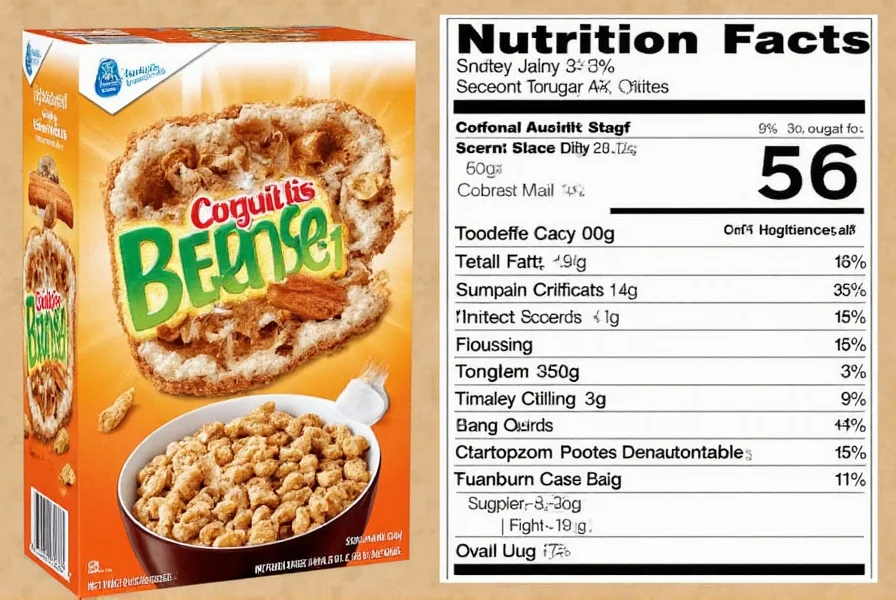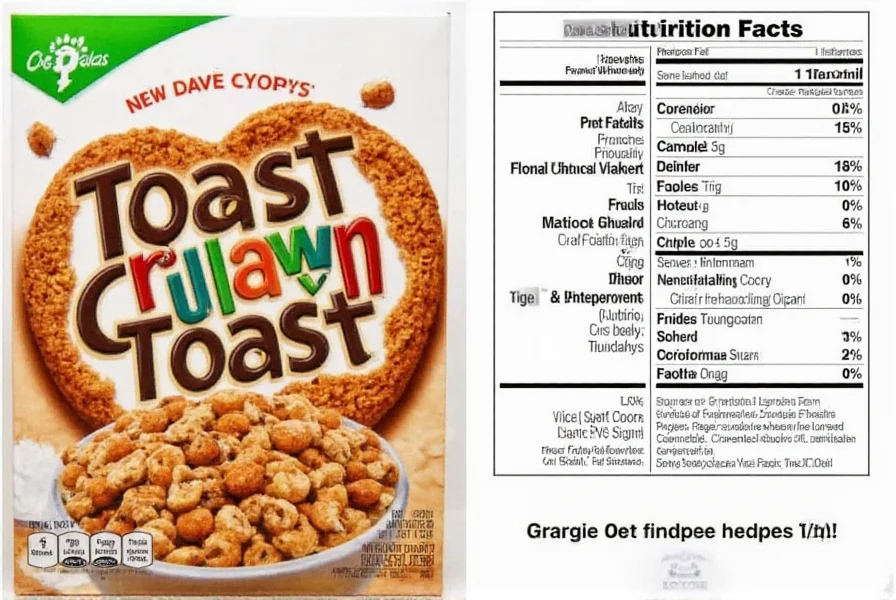Cinnamon Toast Crunch is not considered a healthy breakfast cereal due to its high sugar content (9g per serving), low fiber (1g), and processed ingredients. While it does contain some fortified vitamins and whole grains, the sugar-to-fiber ratio and artificial ingredients make it a poor nutritional choice for regular consumption, especially for children.
When evaluating whether is cinnamon toast crunch healthy, it's essential to examine its nutritional profile objectively. This popular cereal has maintained a strong market presence for decades, but its nutritional value raises significant concerns for health-conscious consumers and parents.
Nutritional Breakdown of Cinnamon Toast Crunch
A standard 3/4 cup (58g) serving of Cinnamon Toast Crunch contains:
| Nutrient | Amount Per Serving | % Daily Value |
|---|---|---|
| Calories | 200 | 10% |
| Total Fat | 5g | 6% |
| Saturated Fat | 1.5g | 8% |
| Trans Fat | 0g | 0% |
| Cholesterol | 0mg | 0% |
| Sodium | 240mg | 10% |
| Total Carbohydrates | 36g | 13% |
| Dietary Fiber | 1g | 4% |
| Sugars | 9g | - |
| Protein | 2g | 4% |
Sugar Content Analysis: A Major Concern
One of the most significant issues when determining is cinnamon toast crunch healthy for kids is its sugar content. With 9 grams of sugar per serving (equivalent to about 2¼ teaspoons), it exceeds the American Heart Association's recommendation of no more than 25g of added sugar per day for children. The cereal derives approximately 45% of its calories from sugar, creating a nutritional profile that's heavily skewed toward simple carbohydrates.
Many consumers don't realize that how much sugar in cinnamon toast crunch compares unfavorably to other popular cereals. While some brands have reduced sugar content in recent years, Cinnamon Toast Crunch has maintained its original formula, making it one of the sweeter mainstream cereal options available.

Whole Grains and Fiber: Limited Benefits
Cinnamon Toast Crunch does contain whole grain corn as its first ingredient, which provides some nutritional advantage over refined grains. However, the cinnamon toast crunch nutrition facts reveal only 1 gram of fiber per serving—significantly below the recommended 25-38 grams of daily fiber for adults. This low fiber content means the cereal doesn't provide sustained energy or promote digestive health effectively.
The whole grain content represents a positive aspect, but it's overshadowed by the high sugar-to-fiber ratio. For a cereal to be considered truly healthy, nutritionists generally recommend at least 3 grams of fiber per serving with less than 5 grams of added sugar.
Vitamin Fortification: A Silver Lining
One redeeming quality in the cinnamon toast crunch ingredients analysis is its fortification with several essential vitamins and minerals. The cereal contains added iron, zinc, and several B vitamins (thiamin, riboflavin, niacin, and folate). These fortifications help prevent certain nutrient deficiencies, particularly in children who might have limited dietary variety.
However, experts caution that fortified nutrients shouldn't be considered a substitute for obtaining vitamins and minerals from whole foods. The presence of added nutrients doesn't transform a high-sugar, low-fiber product into a health food.
Artificial Ingredients and Additives
Examining the full ingredient list reveals several components that raise questions about is cinnamon toast crunch better than other cereals. The product contains artificial flavors, TBHQ (tertiary butylhydroquinone—a preservative), and Red 40 coloring. While these ingredients are FDA-approved, many health-conscious consumers prefer to avoid them when possible.
The "Crunchimizer" pieces—those distinctive sweet squares that melt in milk—contain additional sugar, corn syrup, and artificial flavors. This component significantly contributes to the cereal's overall sugar content and processed nature.
Comparison to Healthier Cereal Options
When evaluating is cinnamon toast crunch healthy in context, comparing it to alternative options provides valuable perspective. Consider these nutritional differences:
| Cereal | Sugar (per serving) | Fiber (per serving) | Protein (per serving) |
|---|---|---|---|
| Cinnamon Toast Crunch | 9g | 1g | 2g |
| Cheerios | 1g | 3g | 3g |
| Shredded Wheat | 0g | 6g | 5g |
| Kashi 7 Whole Grain | 6g | 6g | 6g |
| Plain Oatmeal (cooked) | 0g | 4g | 6g |
This comparison clearly shows why nutritionists typically recommend healthy alternatives to cinnamon toast crunch for regular consumption. The significant differences in sugar, fiber, and protein content illustrate why many health professionals consider Cinnamon Toast Crunch more of a dessert than a breakfast food.

Considerations for Different Dietary Needs
For families wondering is cinnamon toast crunch suitable for children, the answer depends on frequency of consumption and overall dietary patterns. Occasional consumption as part of a balanced diet won't cause harm, but regular consumption could contribute to poor eating habits and excessive sugar intake in children.
Individuals with diabetes or blood sugar concerns should be particularly cautious, as the high glycemic index of this cereal can cause rapid blood sugar spikes. Those seeking weight management might find the low satiety value (due to minimal protein and fiber) makes this cereal a poor choice for maintaining fullness until the next meal.
How to Make Cinnamon Toast Crunch Somewhat Healthier
If you or your family enjoys Cinnamon Toast Crunch but want to improve its nutritional profile, consider these practical modifications:
- Mix half Cinnamon Toast Crunch with half plain shredded wheat or bran flakes to reduce sugar content
- Add fresh berries or sliced bananas for natural sweetness and additional fiber
- Use milk with higher protein content (like cow's milk or soy milk) instead of water or plant-based milks with low protein
- Add a scoop of protein powder to milk before pouring over cereal
- Include a side of Greek yogurt or a hard-boiled egg to increase protein intake
Final Assessment: Where Cinnamon Toast Crunch Fits in a Healthy Diet
After comprehensive analysis of the cinnamon toast crunch nutrition facts, it's clear this cereal should be viewed as an occasional treat rather than a daily breakfast staple. The high sugar content, low fiber, and processed ingredients outweigh the benefits of its whole grain content and vitamin fortification.
Nutrition experts generally agree that breakfast cereals with at least 3 grams of fiber and less than 5 grams of added sugar per serving represent better choices for regular consumption. While Cinnamon Toast Crunch delivers on taste and nostalgia, it falls short on nutritional value compared to many alternatives available today.
How much sugar is in Cinnamon Toast Crunch?
A standard 3/4 cup (58g) serving of Cinnamon Toast Crunch contains 9 grams of sugar, which is approximately 2¼ teaspoons. This represents about 45% of the cereal's total calories coming from sugar.
Does Cinnamon Toast Crunch have any nutritional benefits?
Yes, Cinnamon Toast Crunch does contain some nutritional benefits including whole grain corn as the first ingredient and fortification with several vitamins and minerals (iron, zinc, and B vitamins). However, these benefits are outweighed by its high sugar content and low fiber.
Is Cinnamon Toast Crunch suitable for children?
Cinnamon Toast Crunch can be consumed occasionally by children as part of a balanced diet, but it's not recommended for daily consumption due to its high sugar content (9g per serving) and low fiber (1g). Regular consumption may contribute to poor eating habits and excessive sugar intake in children.
What are healthier alternatives to Cinnamon Toast Crunch?
Healthier alternatives include plain oatmeal with cinnamon and fruit, shredded wheat, Cheerios, or Kashi 7 Whole Grain. These options typically have less sugar (under 5g per serving), more fiber (at least 3g), and higher protein content while still providing some sweetness or familiar flavors.
Can Cinnamon Toast Crunch be part of a balanced diet?
Yes, Cinnamon Toast Crunch can be included occasionally in a balanced diet, but it shouldn't be a regular breakfast choice. To make it somewhat healthier, consider mixing it with a higher-fiber cereal, adding fresh fruit, or pairing it with a protein source like Greek yogurt or eggs to balance the meal.










 浙公网安备
33010002000092号
浙公网安备
33010002000092号 浙B2-20120091-4
浙B2-20120091-4